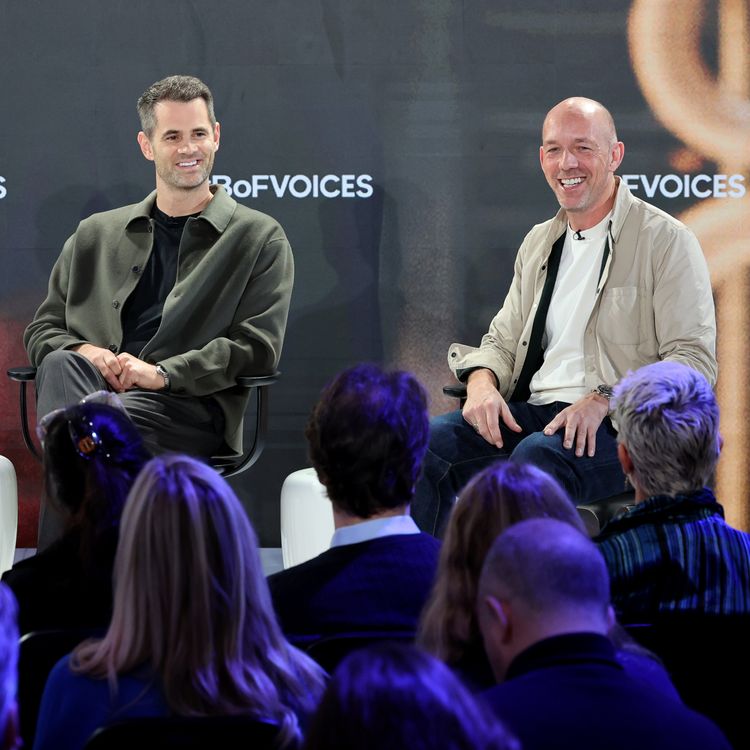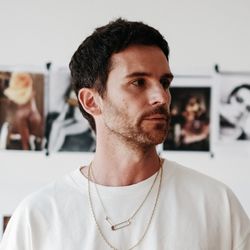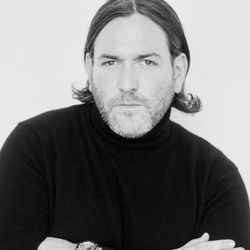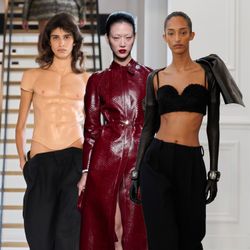Share

The Business of Fashion Podcast
How Skims and On Create Cultural Relevance
•
Many fashion brands are realising that operating across multiple cultural sectors is a business necessity. In our social feeds, fashion competes with music, film, and sports for our attention.
Learning how to tap into other cultural sectors is something that many fashion brands are trying to do, but few have done it better than this week’s guests.
At BoF VOICES 2024, BoF founder and CEO Imran AmedI spoke with Jens Grede, co-founder and CEO of Kim Kardashian’s Skims, the shapewear brand and David Allemann, co-founder and executive co-chairman of the Swiss sportswear company On, to learn how they’ve tapped into the cultural zeitgeist, especially at the growing intersection of sports and fashion.
Key Insights:
- For both Grede and Allemann, the foundation of a successful brand lies in creating exceptional products. Grede emphasises the critical importance of innovation, crediting Skims’ success to years of fabric development before launching the brand. “Before a brand, there are products, and you can’t build a great brand without a great product,” he explains. Similarly, Allemann shared On’s origins, which began with a makeshift prototype crafted from a garden hose to test their signature “cloud tech” soles.
- Sports and fashion have become deeply interconnected, reflecting how cultural and personal identity have evolved. Allemann notes that, over the past 15 years, sportswear has transitioned from functional equipment to an extension of one’s personality, becoming a new uniform. “Because it becomes part of our personality, it’s elevated to a whole different level, and so in a sense, [sport] becomes fashion.” Athletes now use fashion as a platform to build their personal brands, with Grede describing it as “a superpower” that amplifies their influence beyond their sport.
- Tapping into culture is essential for brands looking to stay relevant and expand their influence. Grede describes building a brand as finding “a little part in this moment in popular culture,” which requires an understanding of the zeitgeist. For Skims, partnerships like their recent collaboration with Dolce & Gabbana push the brand into uncharted aesthetic territory while providing customers with something entirely new. On takes a similarly thoughtful approach, having turned Roger Federer from an ambassador into an investor.
- As brands grow, the decision to go public can be a significant milestone, but timing is critical. Grede acknowledges that Skims will eventually become a public company but stressed the importance of focusing on expansion and building away from the scrutiny of the public eye. Allemann shared advice from On’s IPO journey, describing the need to stay close to the customer: “On really tries to be very close to the consumer and be the brand that helps the explorers and the dreamers and probably even the rebels to ignite their spirit. I think that's what's really important right now.”
Additional Resources:
More episodes
View all episodes

Satoshi Kuwata Is on a Lifelong Search for Balance
01:00:04|After years of honing his craft at Savile Row, studying at Central Saint Martins, and working for Givenchy, Edun and Golden Goose, Japanese designer Satoshi Kuwata created the brand Setchu, a deeply personal response to his passion for blending Japanese and Western ideas. Grounded in precision tailoring and shaped by the poetic restraint of the kimono, Kuwata’s work reflects a lifelong pursuit of balance – between cultures, between past and future, and between creativity and business. “Once you meet the Western garment, it's free. You can do whatever you want. Some people go too crazy, but designers like Rei Kawakubo, and Yohji Yamamoto are geniuses, for understanding the flow of the fabric, understanding the shape of it but still keeping their Japaneseness,” shares Kuwata.Kuwata joins BoF Founder and CEO Imran Amed to explore how his Japanese upbringing shaped his creative vision, how Savile Row and Saint Martins gave him the tools to execute it, and why he’s just as focused on designing a company as he is designing clothes.Key Insights: Kuwata's design identity is rooted in a lifelong tension between his Japanese heritage and Western training. Having studied Savile Row tailoring and graduated from Central Saint Martins, he continues to explore how 2D kimono principles and 3D Western garment construction can coexist in one garment and one brand. “Setchu is the journey of finding the right balance,” he says.Kuwata’s years at Savile Row shaped his technical fluency and deep respect for tradition. “I really loved British designers because of tailoring … because that’s the most complicated garment,” he says. Working at prestigious houses like Huntsman, he absorbed a culture of precision, etiquette and generational craftsmanship. “I was probably the last generation to feel or to experience that kind of old culture,” he reflects. That foundation now anchors his design approach, even as he pushes toward innovation.Kuwata wants Setchu to be a new kind of fashion company that is collaborative, thoughtful, and grounded in mutual respect. He believes in designing a workplace culture as intentionally as he designs garments. “As a leader, … I'd like to design a company as well. I'd like to design a beautiful relationship as well, he says. “If I have a good team, I don’t need to tell them to finish on time – they’ll do it even earlier.”Building an independent brand comes with real challenges, from financial anxiety to industry expectations, but Kuwata reframes pressure as opportunity. “Fashion is fashion. It’s not 100% that people love your collection. I don't take it as pressure. I always take it as an opportunity, and I always dream big.”Additional Resources:Satoshi Kuwata | BoF 500 | The People Shaping the Global Fashion Industry Satoshi Kuwata’s Setchu Wins the 2023 LVMH Prize | BoF
H&M's AI Models and the Future of Fashion Marketing
18:52|Fast-fashion giant H&M recently announced its plans to deploy AI-generated "digital twins" of real-life models in marketing campaigns. While H&M argues it's proactively managing inevitable industry changes, including by working with models to compensate them for use of their AI versions, the decision has sparked significant backlash. Comments on social media and statements by industry figures highlight deep-seated anxieties around job security, creative integrity and the value of the human element in fashion. BoF correspondents Marc Bain and Haley Crawford discuss the potential outcomes and tensions arising from AI’s expanding role in fashion marketing.Key Insights: H&M is just the tip of the iceberg: Fashion brands are increasingly embracing AI, from fast fashion to luxury. While AI-generated imagery has quietly infiltrated lower-end markets for some time, H&M's public embrace signifies its move out into the open, and into the world of high-profile campaigns. High-end brands like Coach and Estée Lauder have started using AI for product-focused imagery, indicating a cautious yet clear shift. "Coach uses Adobe Firefly to create digital twins of its products… to scale marketing content and test designs," says Crawford, highlighting how AI is already reshaping marketing across the fashion spectrum.Transparency around AI use in marketing is still inconsistent, and regulations are lagging behind. "The technology is moving so rapidly, it's making its way out into the world already, and the law is trying to catch up," Bain explains. While the EU is moving toward legislating transparency in AI-generated imagery, the lack of clear rules globally adds complexity for brands and consumers alike, creating uncertainty around ethical marketing standards.The rise of AI-generated imagery raises concerns over the loss of the creative collaboration intrinsic to traditional fashion shoots. "What's really at risk of being lost here is that communal process of creating fashion imagery," says Bain. "Some level of creativity and humanity, in addition to all the jobs themselves, which are also hugely important, will also be lost."As AI image generation continues to be adopted by brands, it is creating increased competition, forcing both digital and traditional creatives to innovate further. "You can't only live in an endlessly self-referential cycle of AI image generation, even if AI is piecing different concepts together to generate newness," Crawford says. "People working on photography, art, whatever the artistic format is, will only get more creative and people are going to experiment more to stand out."Additional Resources:H&M Knows Its AI Models Will Be Controversial | BoFThe Fake Fashion Campaigns That Show AI’s Future in Marketing | BoF
Coldplay’s Guy Berryman Says He Makes Clothes the Way He Makes Music
38:35|Guy Berryman grew up with an engineer's mind and a passion for making things. After studying mechanical engineering and architecture, he found global fame as the bassist of Coldplay. But his love for making things never went away. In 2020, he launched Applied Art Forms, a clothing label that draws inspiration from utilitarian design, military garments and mid-century modern aesthetics.Now stocked in over 50 stores worldwide, including Dover Street Market, the brand is growing slowly but deliberately, with a creative process that he likens to making music. “The way I make things is very much like [how] we make songs, which is you throw ideas down and then you listen to it, judge it and see what it is. It’s a very sculptural process, says Berryman. “I'm not just backing someone else's brand. This is absolutely hands on, this is my baby.”This week on the BoF Podcast, Berryman joins BoF founder and CEO Imran Amed to discuss the steep learning curve of building a fashion business, why quality and longevity matter more than hype, and how his creativity flows across creative disciplines. Key Insights: Berryman describes himself as having "an engineer's brain," shaped by his background studying mechanical engineering and architecture. This maker's mentality underpins his meticulous, hands-on approach at Applied Art Forms – from crafting prototypes to obsessing over garment details. "I'm on the studio floor, my hands and knees cutting, sewing, gluing, stitching," he says. "This is absolutely hands on."Berryman designs garments with longevity in mind. "I always feel like clothes actually get better the more you wear them," he says. "I feel that way towards everything that we're doing and I like the idea that everything that people buy from us is going to be with them for a long period of time."Despite his passion for clothing, Berryman admits he entered the fashion industry naively. He quickly learned that building a brand from scratch requires humility and perseverance. "Nothing can prepare you for the reality of making and selling clothes. It's an incredibly brutal industry to be in," he says. "What I've come to realise is you can only survive in it if you're completely passionate about the process.”Working in fashion hasn’t taken away from his role in Coldplay, but rather enhanced it. "Having a creative outlet elsewhere has allowed me not to feel like I have to impose myself creatively into the band," Berryman says. He approaches clothing the same way he makes music: "You listen to it, judge it and see what it is. It’s a very sculptural process."Additional Resources:Will Dover Street Market’s Big Bet on Independent Fashion Pay Off? | BoFThis episode includes a short clip from "Yellow," written by Chris Martin, Guy Berryman, Jonny Buckland, Will Champion, performed by Coldplay (© 2000, Parlophone Records).
What Happened to Pat McGrath Labs?
29:21|Pat McGrath is widely regarded as one of the most influential makeup artists of all time. Known simply as “Mother” to some in the industry, she’s been behind some of the most memorable runway beauty moments for decades. In 2015, she launched her namesake brand, Pat McGrath Labs, which quickly became a beauty phenomenon – going viral with its glittering gold pigment and reaching a $1 billion valuation just two years later.But almost a decade on, the business tells a different story. With its valuation now a fraction of what it once was, high executive turnover, limited product accessibility, and internal challenges, the brand’s future hangs in the balance – even as McGrath's own star continues to rise with a new role as beauty director for Louis Vuitton.The Business of Beauty editor Brennan Kilbane and executive editor Priya Rao, explore what went wrong and how the business can get back on track.Key Insights: In its early years, Pat McGrath Labs thrived as a high-concept beauty brand that translated runway artistry into consumer excitement. The first product, Gold 001, was a multipurpose pressed gold pigment that sold out within minutes and crashed the website. As Kilbane describes, the brand began as “a direct pipeline from her creative brain to the cosmetics market.” The initial success solidified McGrath’s cult status – and set high expectations for what came next.When Pat McGrath's 'glass skin' look went viral after the Maison Margiela couture show, it could have been a pivotal brand moment. But the product inspired by the look – and released more than a year later – failed to maintain momentum. “They tried to capitalise on it by scheduling a masterclass a week later,” says Kilbane, “but it wasn’t fast enough.” Additionally, according to Rao, the bigger issue with late deployment was product wearability: “It’s not something that’s everyday or wearable in any capacity.”Pat McGrath’s artistry is legendary, however operationally, Pat McGrath Labs fell flat. “Pat McGrath Labs was Pat McGrath. She is the CEO, she is the founder, she's the creative director – the buck stops with her,” says Kilbane. With final say on everything from product formulation to packaging, this all-encompassing control created a bottleneck that affected every part of the business. The result was a company where decision-making was slow and fragmented.With valuation plummeting and Sephora shelf space dwindling, both Kilbane and Rao agree that McGrath’s company needs a reset. “Does it need new investors? Probably,” says Rao. “But it also needs leadership and operational know-how for it to actually scale. Otherwise, it’s going to be a pet project in comparison with what she does with Louis Vuitton.” Kilbane adds, “Fixing the company culture is going to be integral – if not even more impactful than integral – to the brand’s longevity.”Additional Resources:What Happened to Pat McGrath Labs? | BoF Louis Vuitton to Launch Makeup Line | BoF
Thom Bettridge Says Viral Magazine Covers Are Only Sugar Highs
46:24|i-D magazine was founded in 1980 by Terry and Tricia Jones, pioneering a new kind of fashion storytelling that mixed street style with high fashion, always with an eye — and a wink — to the future. The magazine has had its ups and downs, and in 2023 fell victim to the bankruptcy of Vice, which had acquired i-D from its founders in 2012. Enter Karlie Kloss and her burgeoning media company, Bedford Media, which has plans to revitalise i-D under a new editor-in-chief, Thom Bettridge with experience at 032c, Interview, Highsnobiety, and Ssense. Now, Bettridge is on a mission to re-establish i-D as a cultural institution for a new generation — one that values community over clicks and retention over viral attention.“I've worked on viral covers and while they can do so much for your exposure as a small brand, at the end of the day, it's really like a sugar high. That famous person's fans are there to see the person they like. Not that many of them actually stick around,” says Bettridge. “We're moving from this attention era to a retention era, where the smarter brands are figuring out how to build a narrative people are invested in.”Bettridge joins BoF founder and CEO Imran Amed to talk about his journey to i-D and what it takes to relaunch an iconic title for a new era.Key Insights: Moving from biannual publications like 032C to the fast-paced, blog-style environment of Highsnobiety, Bettridge learned to step back from editing every piece, focusing instead on nurturing a team that could maintain quality content at a rapid digital pace. "I had to cultivate a team that is going to do great work even when I'm not directly touching it," he says. "It was a big growth thing, learning how to be more of a coach than an editor of editors."At e-commerce platform Ssense, Bettridge discovered content was most successful when it offered intrinsic value, fostering long-term brand loyalty. He likens Ssense's editorial content to a great coffee shop attached to a hotel: Even if people aren’t shopping for luxury fashion every day, they could drop by for a daily dose of engaging content, building a habitual connection to the brand. "What really worked was if you just made great content, you then became part of someone's digital diet in a way that built loyalty with the brand," he explains.For the relaunch cover of i-D, Bettridge chose Enza Khoury, a trans woman living in the Republican state of Ohio in the US, after a casting call brought in over 800 video submissions. “We really wanted to find someone who encapsulates the present moment, and feels like a representative of our time,” Bettridge explains. In addition to her charisma, Enza’s personal story captured something bigger. “It almost felt like her life was telling a story of what it means to live today.”Bettridge emphasises shifting from viral celebrity-driven covers to nurturing a dedicated audience. He describes viral covers as a "sugar high," suggesting the real value lies in sustained engagement. "You can create this huge wave of eyeballs, but are these people actually going to buy what you're selling?" he asks. The goal, he says, is to transition "from an attention era to a retention era." Additional Resources:i-D Magazine Appoints Thom Bettridge Editor in Chief Op-Ed | Go Big or Go Hyper-Niche
Is Forever 21 Shein's Biggest Victim Yet?
21:36|Once a dominant player in fast fashion, Forever 21 recently filed for bankruptcy for the second time in six years, marking the likely end of its run as a physical retailer. The chain, known for introducing ultra-affordable, trend-driven clothing to American malls, struggled to remain relevant as competitors like Zara, H&M, and later Shein and Temu offered faster, cheaper, and more digitally-savvy alternatives. After its initial bankruptcy in 2019, Forever 21 was acquired by Authentic Brands Group and mall operator Simon Property Group, but despite various turnaround attempts – including unusual collaborations and international relaunches – it failed to recapture its former success.Retail editor Cathaleen Chen joins The Debrief to unpack what Forever 21’s fall says about the future of fast fashion.Key Insights: Chen argues that Forever 21’s downfall is largely due to its loss of cultural cachet. “You don't see influencers peddling Forever 21 in the way that you see influencers still promoting Shein, and I think that's a huge factor. You have to spend that money to be relevant,” says Chen.Chen contends that fast fashion retailers like Forever 21 have always struggled with establishing a unique identity, which ultimately made it difficult for them to maintain customer loyalty. “The problem with Wet Seal, Rue 21, and now Forever 21 is that these retailers never really had any kind of identity,” she explains.The retailer’s failure to evolve beyond chasing transient trends has left it vulnerable to more agile competitors. “It's not about just chasing fashion, fashion, fashion the way that I think Forever 21 never got out of, the way that Shein dominates. It's about going the other direction and creating products that your customers want at a level of quality,” says Chen.Looking forward, success in fast fashion will require more than affordability. Chen believes future winners must combine low prices with a compelling retail experience: “There is an element of surprise and delight in that shopping experience. It can't just be cheap, affordable – it needs to offer something more.”Additional Resources:The Year Ahead: Deconstructing Fast Fashion’s Future | BoF Why Shein Keeps Buying Its Rivals | BoF
Breaking News: Demna Takes Gucci, Versace Enters a New Creative Chapter
26:38|Demna's move to Gucci, announced after weeks of feverish speculation, stunned industry observers and sent shockwaves through financial markets, with Kering shares dropping sharply by more than 12%. While some hail this as an opportunity for Demna to reinvent Gucci through his distinctive cultural lens, others question his ability to break free from his Balenciaga legacy.. BoF founder and editor-in-chief Imran Amed posits, “The really big question here is, can Demna do something different?”Meanwhile, Donatella Versace’s transition from Chief Creative Officer to Chief Brand Ambassador marks the end of a storied era and the beginning of a new chapter under Dario Vitale. Highlighting Donatella’s cultural impact, BoF editor-at-large Tim Blanks notes, “Versace was one of the few names that registered with people who didn't know anything about fashion.” Fresh off a stellar tenure at Miu Miu, where he helped to ignite record growth, Vitale faces the ambitious task of balancing Versace's iconic legacy with a renewed contemporary relevance. With whispers of potential acquisition by Prada Group swirling, Versace stands at the precipice of transformation.Additional Resources:Why Gucci Picked Demna | BoF Dario Vitale to Succeed Donatella Versace as Chief Creative Officer of Versace | BoF
Tim Blanks and Imran Amed Reflect on Autumn/Winter 2025
52:49|This season, all eyes were on the debuts of Haider Ackermann at Tom Ford and Sarah Burton at Givenchy. Meanwhile, designs at Alaïa and Valentino continued to push boundaries with daring silhouettes that either stood away from the body or felt purposely incomplete. Behind the new faces and unconventional shapes was a deeper exploration of eroticism. From Ackermann’s sensual glamour at Tom Ford to what Tim Blanks calls the “quiet eroticism” of Burton’s Givenchy, designers seemed united by a playful fascination with the body — and a desire to subtly challenge its boundaries.“Fashion is a very fetishistic art form,” says Tim Blanks, BoF’s editor-at-large. “It has its fixations on the body and the way it fetishizes objects, but fashion is about fetishizing beauty and ugliness. A lot of these different things have been coming up over the last few years.”Following the conclusion of the Autumn/Winter 2025 shows, Blanks sits down with BoF founder and editor-in-chief Imran Amed to discuss the highlights of fashion month.Key Insights: Across the season, there was plenty of body on display. At Alaïa, Pieter Mulier presented striking new silhouettes that played with unusual proportions, creating shapes that stood away from the body. These exaggerated forms, described vividly by Amed as "body condoms," challenged the relationship between clothes and the body. At Duran Lantink, prosthetic pieces humorously toyed with ideas of eroticism. “What are they trying to say with these clothes?” asks Blanks. “There is a new body consciousness and people want to show off their svelte new forms.”Ackermann’s debut successfully merged Tom Ford’s famed sexual glamour with a reflective, intimate approach. “Tom is a sexualist and Haider is a sensualist, but there was a compatibility there in the erotic rigour in both of their work,” says Blanks. “I thought Haider did a wonderful job of doing a Haider Ackermann for Tom Ford collection; honouring the essence of one, but really bringing the dynamism of the new.”Also facing a house with a storied heritage, Burton’s debut collection for Givenchy returned to its earliest codes and patterns. “We haven't seen something that's projecting Givenchy into the future but also really grounded in the past. And I think that's what clicked, because the other attempts were either too much in the future and disconnected from the past, or too much in the past and not taking it anywhere new,” says Amed. “She proved what a great designer she is,” adds Blanks.Watching from home, Blanks was struck by the step-and-repeat that preceded the Off-White show, where attendees arrived in bold, expressive looks from the brand’s current collection. This real-life display of style, Blanks notes, “softened him up” for the actual runway. “You see the clothes on real people, so it's not like, ‘Who would wear this?’” he says. Amed highlights this as an added opportunity to capture customers watching online: “There's a step-and-repeat for what's available to buy now, and then there's the show for what's available for the future.”Additional Resources:Sarah Burton’s Givenchy Debut: First Principles Take FlightAckermann and Ford: A Deliciously Dangerous Liaison